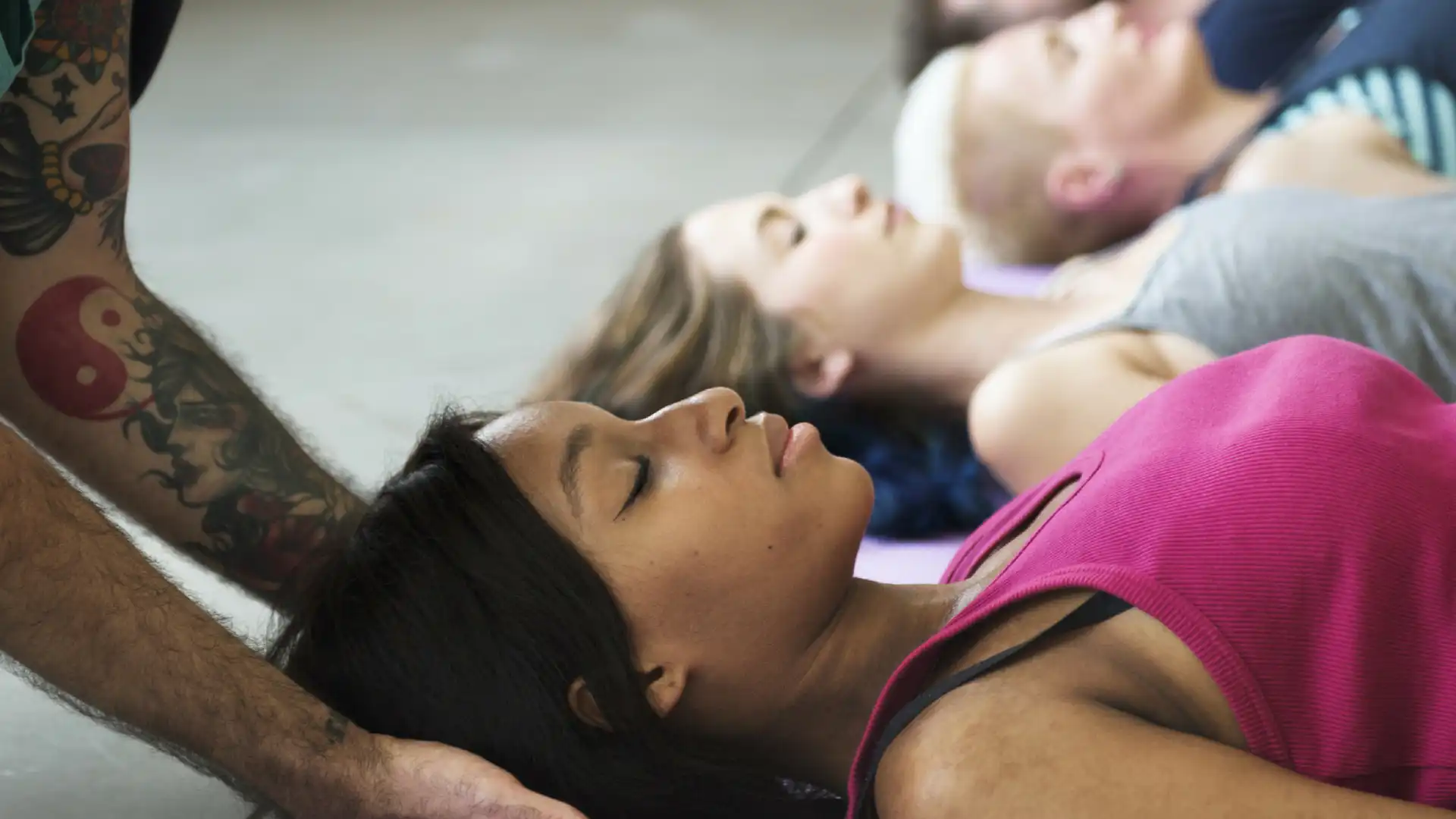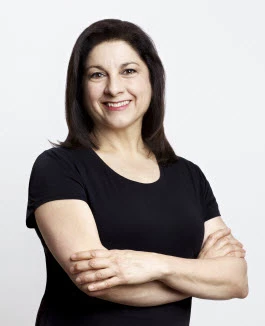Yoga for Neck and Shoulder Pain: Healing the Mid-Back Core

Article At A Glance
How can yoga help with neck and shoulder pain? Learn from Yoga Therapist Robin Rothenberg’s journey and her approach to healing through functional movement and breath.
Are neck and shoulder pain the new back pain? Neck pain is now the fourth leading cause of years lost to disability, according to a 2010 study by The Institute for Health Metrics and Evaluation.
We spend hours a day hunched over computers and smartphones, and it’s taking its toll. About half of the population will experience a “clinically important” episode of neck pain over the course of their lifetimes, and for nearly 50% of these, chronic pain and secondary ailments, like headache, shoulder tension, jaw, and back pain, and even depression will persist, sometimes for years.
Robin Rothenberg, a Yoga Therapist, author of “The Essential Low Back Program,” and a contributor to creating the research protocol for some of the leading studies on yoga for back pain, is well familiar with the wide-ranging and debilitating effects of a neck injury.
She experienced an injury early in her career that sidelined her for months and led her to a multi-pronged process of inquiry and exploration. Today a large focus of Robin’s work is in utilizing adaptive asana and breathing practices to break chronic pain patterns and reset the body to move with greater stability and freedom.
How Can Yoga Help People Suffering from Neck and Shoulder Pain?

Addressing neck and shoulder pain with palliative relaxation techniques, such as yoga stretches, is rarely enough, Robin notes. While the pain may be localized in the neck and shoulders, the problem is more often than not emanating from elsewhere, such as a misalignment in the ribcage, poor abdominal and mid-back core support, or a dysfunctional breathing pattern.
To be effective, therefore, long-term solutions need to include functional movement, functional breath, and balanced action throughout the neck and shoulder girdle.
In addition to everyday stress, neck and shoulder pain is often caused by postural habits, particularly slumping over the computer keyboard for hours at a time. That’s where dysfunctional breath habits come into play.
“When we sit in our computer slumped position, we effectively cut off the abdominals from the diaphragm, and as a result, the diaphragm is no longer doing working efficiently,” Robin explains. “Instead, the accessory muscles of the chest become primary breathers. As a result, people breathe up instead of out. For the approximately twenty to thirty thousand times a day we breathe, the musculature in the neck and shoulders is contracting. This creates chronic tension all the way up through the shoulders and neck, the jaw, as well as headaches, tension in the head, TMD, joint pain, and tension around the eyes.”
When Yoga Practice Can Hurt Instead of Heal
While yoga can help relieve neck and shoulder pain, it can also be the cause of it. For yogis, trouble can also stem from attempting to do too much too soon, especially when it comes to weight-bearing poses that require upper body strength and support.
Robin had a neck injury in the early days of her practice. She traces her injury to an overly aggressive yoga practice that included headstand variations with inadequate prep and little awareness of the proper body mechanics and alignment required to execute such poses.
The moment Robin realized there was a problem is etched in her memory:
“I was teaching, and I remember very distinctly raising my arms to do Virabhadrasana II,” she recalls. “I said, ‘Okay, inhale and raise your arms.’ My right arm fell down, and I couldn’t lift it back up again. Inside, I’m thinking, ‘That’s not good.’ The result of my shoulder and neck imbalance and weakness was compression, which ended up with some thoracic outlet and numbness, tingling, and weakness, all down my arm.”
Robin was diagnosed with cervical disc compression at C4-C5 and spent about eighteen months in acute pain that she describes as intense. ”By four o’clock in the afternoon, I was pretty much on the couch saying, like, “Morphine, I don’t care,” she says. Physical Therapy sessions helped a lot, as did working with a yoga teacher. But her own personal inquiry led her to some deeper discoveries besides the fact that any pose that put pressure on or required weight bearing by her upper body was out of the question, at least for the moment.
The Way Back: Working with the Mid-Back Core To Reduce Neck and Shoulder Pain

While an ill-advised yoga practice led to the injury, yoga also became a main factor in healing it.
“I realized that opening up the front body and stretching– which is usually the way shoulder and neck pain is addressed–was not going to solve the issue. The strength part is equally important. And I didn’t have it. What got me in trouble to begin with was that I didn’t have the strength in my upper body and neck to sustain a headstand.”
Robin realized that her path to health and healing was going to be progressive strengthening, as well as accepting that headstand may not be in the cards for her body.
Adaptive asana and adding work with weights were a starting point to healing. Robin credits meeting Tom Myers, author of Anatomy Trains, who has done extensive work in the area of holistic myofascial lines in the body, with opening up a new understanding of what she considered working with her core:
“I met Tom Myers and was introduced to the arm lines, as well as an awareness that the core work that I had utilized with my lower back work goes all the way up.
This developed into a new way of working with the back of the upper body–what I have come to call the mid-back core. It’s an integration of the abdominal core and the neck core and what goes on between those points. The breath plays a big role as well. The center point of the body is the lower ribcage, the diaphragm, and this beautiful link between upper body and lower body if we know how to access it.”
As to what she means by the term “mid-back core,” Robin starts with the Anatomy Trains definition of the Deep Front Line: “That deep inner core line that starts from the inner arches goes up through the inner calves, inner thighs, the adductor complex, pelvic floor, transverse abdominis, iliopsoas, up into the diaphragm, and pericardium. They’re all part of that same deep front line. And it continues up into the longus colli, which are the stabilizers in the deep scalenes, the stabilizers of the neck,” she explains.
While the concept may seem new, Robin traces this connection all the way back to the ancient yogis, equating what she calls the “neck core” to the Jalandhara Bandha muscles.
“The Bandhas and the deep front line are in cahoots. They’re the same thing. The ancient yogis really got it. And that’s why they worked with the Bandhas and they worked with the breath the way they did. And then, we sort of abandoned a lot of those essential tenets of our postural practices to emphasize more of how loose and contorted you could make your body. Unfortunately, we’ve not done ourselves or our students much good. I think we need to get back to that essential understanding of how to stabilize first and mobilize from that very strong, stable center.”
How Yoga Can Help Neck and Shoulder Pain: Stabilize First and Mobilize Second
The need to stabilize first and mobilize second explains why stretching often offers only a temporary fix. “As soon as we come out of the stretch, we go back into our pattern, so there’s a lack of resilience and a bit too much focus on the localized area of tension,” says Robin. “We should be looking at the whole pattern of posture, breath, functional movement, functional breathing from the base all the way up.”
Robin reports that new clients who come to her with neck and shoulder complaints are often surprised to find themselves starting to work on their abdominal cores and pelvic girdles first. “People are often surprised when they work with me whether they come in because they’ve got neck and shoulder issues or when I do my training programs on the neck and shoulder. We start with the engagement of the abdominal core and work our way up and work with functional breathing because we can’t actually transform the upper body without linking it to what’s going on below,” she states.

For Robin, the relationship between functional movement and functional breath is essential. “The diaphragm, which is the central breathing muscle, is also a very important part of the core stabilization complex. It’s designed to work in tandem with the transversus abdominis and the oblique muscles so that when the diaphragm contracts and moves down, the abdominal muscles expand. Then, as you exhale, they contract, which assists the diaphragm in that inward movement where it rises. In other words, functional breathing is very much about the core being engaged appropriately so that the abdominals are always sinking and oscillating with the diaphragm.”
Robin says that employing basic essentials of functional movement can have a big impact on how people feel in their upper bodies. Activating the mid-back core and stabilizers of the upper back in conjunction with the diaphragm and proper breathing is a good first step. At the same time, working on the placement of the shoulders and upper body and learning to initiate movement from the scapula as opposed to the ball joint of the shoulders will create more functional movement.
For yoga teachers, Robin stresses making sure to incorporate functional breathing into asana practices to help people sync the diaphragm back up with their abdominals. This will help to alleviate upper back, neck, and shoulder tension and stabilize and support the lower back.
“You know, that goes together, right?” she asks. “We get the core strong and the core synced with the diaphragm. The diaphragm works more efficiently. People’s nervous system calms down. They get out of that sympathetic fight or flight mode. They’re more relaxed. The whole being feels better as a result. And yoga has this wonderful mind-body asana-breath mindful awareness.”
 Lynn Crimando, MA, is the teaching mentor for YogaUOnline’s Wellness Educator Program. She is a yoga teacher, C-IAYT Yoga Therapist, board-certified Health and Wellness Coach, and a Buteyko Practitioner. She has a private practice in New York City and teaches classes throughout the city on behalf of Health Advocates for Older People. In addition, Lynn is on the faculty of the IAYT-approved Yoga Polarity Therapist Training in Malverne, New York.
Lynn Crimando, MA, is the teaching mentor for YogaUOnline’s Wellness Educator Program. She is a yoga teacher, C-IAYT Yoga Therapist, board-certified Health and Wellness Coach, and a Buteyko Practitioner. She has a private practice in New York City and teaches classes throughout the city on behalf of Health Advocates for Older People. In addition, Lynn is on the faculty of the IAYT-approved Yoga Polarity Therapist Training in Malverne, New York.



